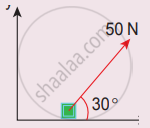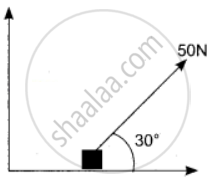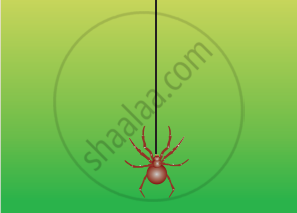Advertisements
Advertisements
Question
A force of 50N acts on the object of mass of 20 kg. shown in the figure. Calculate the acceleration of the object in x and y directions.

Solution
Given F = 50 N and m = 20 kg
(1) component of force along x – direction
Fx = F cos θ
= 50 × cos 30° = 43.30 N
ax = `F_x/m` = `43.30/20` =2.165 ms-2
(2) Component of force along y – direction
Fy = F sin θ = 50 sin 30° = 25 N
ay = `F_y/m` = `25/20` = 1.25 ms-2

APPEARS IN
RELATED QUESTIONS
Choose the correct answer.
Consider the following pair of forces of equal magnitude and opposite directions:
P. Gravitational forces exerted on each other by two-point masses separated by a distance.
Q. Couple of forces used to rotate a water tap.
R. Gravitational force and normal force experienced by an object kept on a table.
For which of these pair/pairs the two forces do not cancel each other’s translational effect?
Choose the correct answer.
Consider following forces: (w) Force due to tension along a string, (x) Normal force given by a surface, (y) Force due to air resistance, and (z) Buoyant force or upthrust given by a fluid.
Which of these are electromagnetic forces?
Choose the correct answer.
A uniform rod of mass 2m is held horizontal by two sturdy, practically inextensible vertical strings tied at its ends. A boy of mass 3m hangs himself at one-third length of the rod. The ratio of the tension in the string close to the boy to that in the other string is
Choose the correct answer.
For which of the following objects will the center of mass not be at their geometrical center?
(I) An egg
(II) a cylindrical box full of rice
(III) a cubical box containing assorted sweets
A stone of mass 2 kg is attached to a string of length 1 meter. The string can withstand a maximum tension of 200 N. What is the maximum speed that stone can have during the whirling motion?
What is the reading shown in spring balance?

A spider of mass 50 g is hanging on a string of a cobweb as shown in the figure. What is the tension in the string?

A block of mass 40 kg slides over a surface when a mass of 4 kg is suspended through an inextensible massless string passing over a frictionless pulley as shown below. The coefficient of kinetic friction between the surface and block is 0.02. The acceleration of the block is ______.
(Given g = 10 ms-2.)

A block of mass M placed inside a box descends vertically with acceleration 'a'. The block exerts a force equal to one-fourth of its weight on the floor of the box. The value of 'a' will be ______.
A steel block of 10 kg rests on a horizontal floor as shown. When three iron cylinders are placed on it as shown, the block and cylinders go down with an acceleration of 0.2 m/s2. The normal reaction R' by the floor if the mass of the iron cylinders is equal and of 20 kg each, is ______.
[take g = 10 m/s2 and µs = 0.2]

